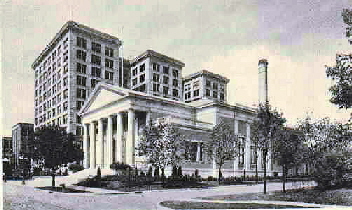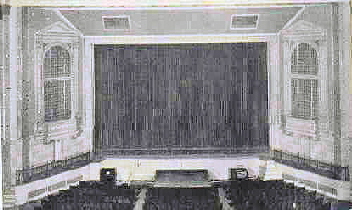|

The NCR Schoolhouse adjoins the main office building and contains a large auditorium with a seating capacity of twenty-two hundred and sixty-three. It has been appropriately called "the powerhouse for brains". It is the center for every activity for NCR employees calling for a large hall, such as motion picturesm stereopticon views, lectures, concerts and other entertainment. It has recently been enriched by the addition of a large Estey Pipe Organ, which is being appropriately dedicated today by an organ recital. This organ has four manuals with fifty four speaking stops. building and contains a large auditorium with a seating capacity of twenty-two hundred and sixty-three. It has been appropriately called "the powerhouse for brains". It is the center for every activity for NCR employees calling for a large hall, such as motion picturesm stereopticon views, lectures, concerts and other entertainment. It has recently been enriched by the addition of a large Estey Pipe Organ, which is being appropriately dedicated today by an organ recital. This organ has four manuals with fifty four speaking stops.
The console represents a new development in the matter of stop control, adding greatly to the convenience and range of the organist. The old form of draw stop has been superseded by a button upon which appears the name of the stop. A simple touch of the finger operates the stop, and a similar touch cancels it. At the same time a small electric light underneath the button is turned off and on. When the stop is on the button is illuminated and the name is easily read, thus showing the organist at a glance what stops are in use. to the convenience and range of the organist. The old form of draw stop has been superseded by a button upon which appears the name of the stop. A simple touch of the finger operates the stop, and a similar touch cancels it. At the same time a small electric light underneath the button is turned off and on. When the stop is on the button is illuminated and the name is easily read, thus showing the organist at a glance what stops are in use.
The stops are also controlled by thirty-one combination pistons, adjustable in groups, controlled by small pistons on the name board, so that any conceivable combination may be set instantly by a touch of the thumb. This ease of operation and convenience of access are distinguishing features of the new console, and are exclusive features of the Estey console.
There is also a second console which operates the complete organ by means of perforated music rolls. Perforated music is arranged expressly for the Estey Organ, which controls not only all stops, but also all expression devices so that the composition is rendered with the same tone color and feeling intended by the composer, and the rendition is, if anything, more complete than can be produced by a skilled organist. This is the self-playing reproducing device which has proved so popular and so successful in the Estey Residence Pipe Organ. The organ is blown by means of an electric 20 horse power motor.
The specifications for this organ were drawn by Henry A. Ditzel, the organist, and the builders gratefully acknowledge his helpful cooperation.
The opening recitals were given by Henry A. Ditzel on Monday, January 22, 1923 & Tuesday, January 23, 1923 and Palmer Christian on Sunday, February 11, 1923.
|
The Specifications for the Organ: Opus 2043, installation year – 1922
|
|
Great
16 Double Open Diapason
8 Open Diapason
8 Second Open Diapason
8 Dulciana
8 Gemshorn
8 Gross Flute
8 Melodia
4 Flute Harmonic
8 Tuba
Swell
16 Bourdon
8 Open Diapason
8 Aeoline
8 Salicional
8 Vois Celeste
8 Viol d'Orchestre
8 Viol Celeste
8 Quintadena
8 Stopped Diapason
7 Wald Flute
2 Flautina
III Solo Flute Mixture
8 Cornopean
8 Vox Humana
Harp
Tremolo
Choir
8 Violin Diapason
8 Viol d'Amour
8 Clarabella
8 Unda Maris
4 Flute d'Amour
2 Piccolo
8 Clarinet
Tremolo
|
Solo
8 Stentorphone
8 Gross Gamba
First Violin III
8 Concert Flute
4 Hohl Flute
8 Saxophone
8 Orchestral Oboe
8 Tuba Mirabilis
Chimes
Marimba
Snare Drum
Tremolo
Pedal
32 Sub Bourdon
16 Open Diapason
16 Bourdon
16 Lieblich Gedackt
16 Trombone
16 Violone
8 Bass Flute
Bass Drum
Cymbals
|
|
Source: Estey Pipe Organs Museum
|

